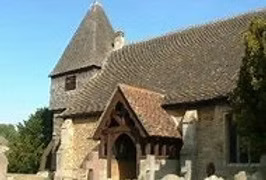Church

The church at Hail Weston is a Grade II* listed building that is dedicated to St Nicolas and consists of a chancel, nave, west tower and south porch. The church was originally built in the 13th century, with some rebuilding in the 15th century; the tower was built in the 16th century. The church was completely restored in 1884 when the south porch was added. The tower contains three bells which have been there since 1709. Hail Weston was part of the same ecclesiastical parish as neighbouring Southoe.
In 2010 a new benefice was formed of Hail Weston, Great Staughton and Little Staughton – the link with Southoe was ended in 2010 but the church remains in the deanery of St Neots within the diocese of Ely.
In 1691 a non-conformist church was formed at Hail Weston and at first they met in a barn until a chapel was built in 1759; the chapel was registered in 1904.
PCC
Hail Weston Parochial Church Council (PCC), the body of locally elected people responsible for the church is considering ways of making the church more accessible to the needs of the community and ensuring that this 800-year-old building continues to offer a place of worship to God for future generations.
Our Churches
Church History
Please click the link below to access an article on the church originally written in June 1989 and updated in October 2025 (contributed by Hilda Williams).